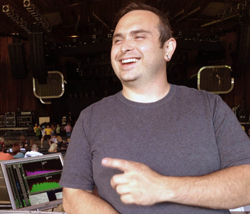
In a dozen years, Jonathan Loeser has risen from SAE Institute graduate to FOH engineer for multi-platinum country act Rascal Flatts. Along the way, he has worked as FOH engineer and production manager for Olivia Newton-John, FOH and monitor engineer for Prince’s “Welcome 2 America” tour, and FOH engineer for Colbie Caillat’s 2011 tour.
One of his “go-to” practices is careful metering and sound analysis, and on the recommendation of colleagues, he recently upgraded to Metric Halo sound analysis software, SpectraFoo, which is paired with his Metric Halo LIO-8 interface, itself recently upgraded to include preamps.
“I originally purchased the LIO-8 to give myself a serious, professional interface that would be flexible enough to do anything I needed it to do,” explains Loeser. “Prior to that, my converter was cheap. It felt like it was going to break in my hand. The LIO-8, together with its companion MIO Console software, gives me all of the routing and flexibility I need.”
Although he had previously used a wireless measurement microphone with line-level output, for the new Rascal Flatts tour, Loeser wanted to expand his monitoring options. “I added the mic preamp option for the LIO-8, which now gives me even more flexibility and portability,” he notes.
Previously, Loeser had used sound analysis software primarily for its transfer function. “With SpectraFoo, I’m still able to do that, of course, but I’m also able to do so much more,” he said. “SpectraFoo is very flexible. For example, when I do a time capture, I can move the point that I want to correlate with, which makes it a much more useful tool. Once I learned how to compose and save snapshot window sets, I configured SpectraFoo to show me everything I want to see for tuning and, separately, for the actual show.”
Part of that functionality includes enhancing his Studer Vista 5’s console’s metering.
Tuning the system requires dealing with Rascal Flatts’ somewhat unconventional stage setup. “We have an extensive thrust, and there’s an apron in front of the stage that makes it hard to fill the gaps that it creates,” Loeser says. “I have some under-hangs that do the trick, but they are touchy. For this tour, I’ve added two Audix measurement mics.
“During system tuning, I’m able to place them in the questionable zone of seating. Then, using SpectraFoo, I can actually see what the down-fills are doing. That’s critical because squeezing good vocal volume out when the main vocal mic is in front of the PA is my biggest potential headache.”
During tuning, Loeser’s custom SpectraFoo screen includes full-frequency transfer functions on the wireless RTA mic, as well as on the thrust mics. He also includes high-resolution, low-frequency transfer functions to properly align the subwoofers.
For the show itself, Loeser flips to another custom SpectraFoo screen. He moves the Audix microphones to a near-audience position on stage that is also used by the monitor engineer for crowd capture. In addition to watching the transfer functions for those microphones, he also takes a feed from the Vista 5 that parallels his send to the PA and gives it a big meter in SpectraFoo.
